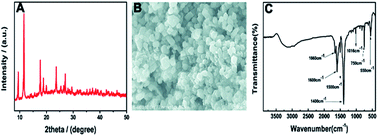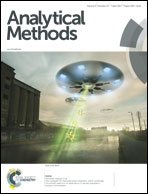A simple modified electrode based on MIL-53(Fe) for the highly sensitive detection of hydrogen peroxide and nitrite
Abstract
A modified matrix of an iron terephthalate metal–organic framework (MIL-53(Fe)), as a simple and efficient electroactive material for use as an electrochemical biosensor, was investigated. The morphology and structure of MIL-53(Fe) were characterized using scanning electron microscopy (SEM), Fourier transform infrared spectroscopy (FT-IR) and X-ray powder diffraction (XRD). The electrochemical properties of the MIL-53(Fe) modified electrode were observed through cyclic voltammetry (CV) and chronoamperometry analysis. The modified electrode (MIL-53(Fe)/GCE) exhibited excellent electrocatalytic activity for the electrochemical reaction of hydrogen peroxide (H2O2) and nitrite (NO2−). Under the optimized experimental conditions, wide linear ranges of 0.1–2000 μM for H2O2 and 0.4–7000 μM for NO2− were obtained, with corresponding detection limits of 0.075 μM and 0.36 μM (S/N = 3), respectively. In addition, the as-prepared electrode also showed excellent reproducibility and long-time stability. Finally, the electrochemical sensor was successfully applied in the analysis of disinfection water and tap water to detect H2O2 and NO2−, respectively.



 Please wait while we load your content...
Please wait while we load your content...